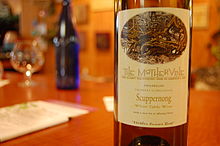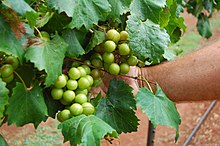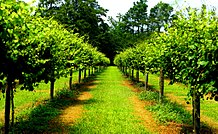
A grape is a fruit, botanically a berry, of the deciduous woody vines of the flowering plant genus Vitis. Grapes are a non-climacteric type of fruit, generally occurring in clusters.

The Concord grape is a cultivar derived from the grape species Vitis labrusca that are used as table grapes, wine grapes and juice grapes. They are often used to make grape jelly, grape juice, grape pies, grape-flavored soft drinks, and candy. The grape is sometimes used to make wine, particularly sacramental and kosher wine. Traditionally, most commercially produced Concord wines have been finished sweet, but dry versions are possible if adequate fruit ripeness is achieved. The grape is named after the town in Massachusetts where it was developed. The grapes are cultivated in many different parts of the world now.

Zinfandel is a variety of black-skinned wine grape. The variety is grown in over 10 percent of California vineyards. DNA analysis has revealed that it is genetically equivalent to the Croatian grapes Crljenak Kaštelanski and Tribidrag, as well as to the Primitivo variety traditionally grown in Apulia, Italy, where it was introduced in the 18th century, and Kratošija in Montenegro. The grape found its way to the United States in the mid-19th century, where it became known by variations of a name applied to a different grape, likely "Zierfandler" from Austria.
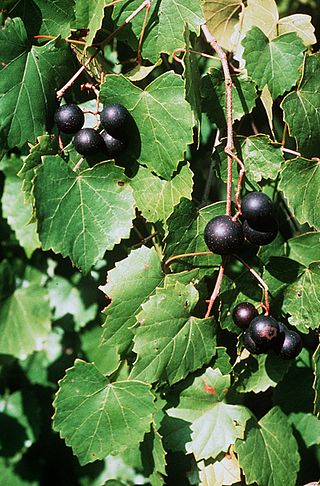
Vitis rotundifolia, or muscadine, is a grapevine species native to the southeastern and south-central United States. The growth range extends from Florida to New Jersey coast, and west to eastern Texas and Oklahoma. It has been extensively cultivated since the 16th century. The plants are well-adapted to their native warm and humid climate; they need fewer chilling hours than better known varieties, and thrive in summer heat.
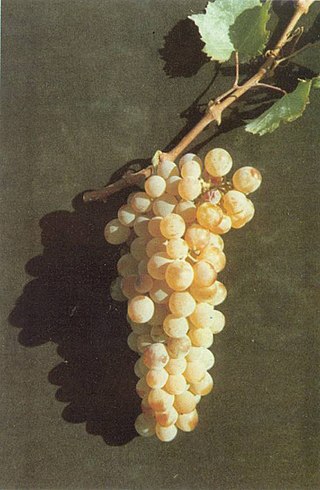
Assyrtiko or Asyrtiko is a white Greek wine grape indigenous to the island of Santorini. Assyrtiko is widely planted in the arid volcanic-ash-rich soil of Santorini and other Aegean islands, such as Paros. It is also found on other scattered regions of Greece such as Chalkidiki. Assyrtiko is also being grown by the Paicines Ranch Vineyard in the San Benito AVA of California with Margins Wine making the wine, by Jim Barry Wines in Clare Valley, South Australia, at the Abbey of New Clairvaux in Northern California since 2011, and at Kefi Winery in Monroe, North Carolina by a first generation Greek family. The original Assyrtiko cuttings were imported in the USA in 1948 by Harold Olmo, grape breeder at the University of California, Davis, where they were stored until the abbey of New Clairvaux took interest in the early 2000s.

Old vine, a common description on wine labels, indicates that a wine is the product of grape vines that are notably old. There is a general belief that older vines, when properly handled, will give a better wine. There is no legal or generally agreed definition for old.

The Yadkin Valley AVA is an American Viticultural Area that includes land in seven counties of northwestern North Carolina. The AVA encompasses an area of approximately 1,400,000 acres (5,666 km2) in the Yadkin River valley. The Yadkin Valley AVA includes all of Wilkes, Surry, and Yadkin counties, and parts of Davie, Davidson, Forsyth, and Stokes counties. Yadkin Valley is home to 44 wineries.

Vitis aestivalis, the summer grape, or pigeon grape is a species of grape native to eastern North America from southern Ontario east to Maine, west to Oklahoma, and south to Florida and Texas. It is a vigorous vine, growing to 10 m or more high in trees. The leaves are 7–20 cm long, suborbicular, and usually a little broader than long; they are variable in shape, from unlobed to deeply three- or five-lobed, green above, and densely hairy below. The flowers are produced at every 3rd node in a dense panicle 5–15 cm long. The fruit is a small grape 5–14 mm diameter, dark purple or black in colour. It is the official state grape of Missouri. Summer grape prefers a drier upland habitat.

Hybrid grapes are grape varieties that are the product of a crossing of two or more Vitis species. This is in contrast to crossings between grape varieties of the same species, typically Vitis vinifera, the European grapevine. Hybrid grapes are also referred to as inter-species crossings or "Modern Varieties." Due to their often excellent tolerance to powdery mildew, other fungal diseases, nematodes, and phylloxera, hybrid varieties have, to some extent, become a renewed focus for European breeding programs. The recently developed varieties are examples of newer hybrid grape varieties for European viticulturalists. Several North American breeding programs, such as those at Cornell and the University of Minnesota, focus exclusively on hybrid grapes, with active and successful programs, having created hundreds if not thousands of new varieties.

The Scuppernong River is a blackwater river that flows through Tyrrell County and Washington County, North Carolina, into the Albemarle Sound. The river shares its name with the Scuppernong grapes native to the area.
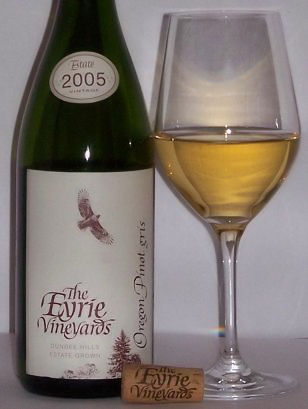
Wine has been produced in the United States since the 1500s, with the first widespread production beginning in New Mexico in 1628. Today, wine production is undertaken in all fifty states, with California producing 84 percent of all US wine. The North American continent is home to several native species of grape, including Vitis labrusca, Vitis riparia, Vitis rotundifolia, and Vitis vulpina, but the wine-making industry is based almost entirely on the cultivation of the European Vitis vinifera, which was introduced by European settlers. With more than 1,100,000 acres (4,500 km2) under vine, the United States is the fourth-largest wine producing country in the world, after Italy, Spain, and France.
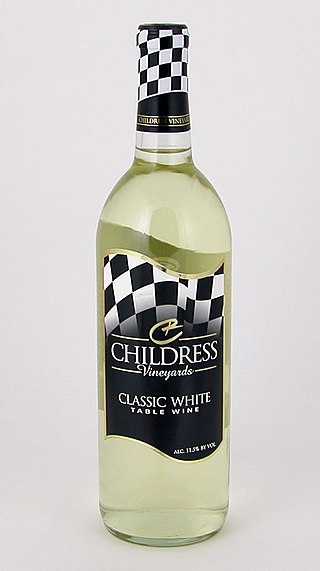
Childress Vineyards is a winery in Lexington, North Carolina owned by NASCAR Cup Series championship team owner Richard Childress. The connection between NASCAR and fine wine is reflected in the labeling of some of the wines produced by Childress, featuring a checkered flag motif.

Vitis (grapevine) is a genus of 81 accepted species of vining plants in the flowering plant family Vitaceae. The genus consists of species predominantly from the Northern Hemisphere. It is economically important as the source of grapes, both for direct consumption of the fruit and for fermentation to produce wine. The study and cultivation of grapevines is called viticulture.
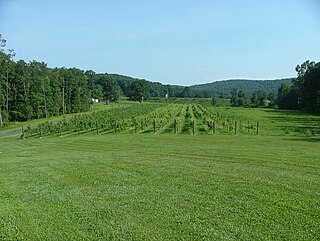
Wine has been produced in the North Carolina area since the early days of European colonization in the 17th century. Wine growers in North Carolina were the first to cultivate a Native American grape variety, the Scuppernong, which produces a sweet wine, examples of which are still being made in the state. Most wine produced in North Carolina since the year 2000 is made from Vitis vinifera grape varieties, although French hybrid and Vitis labrusca varieties remain common.

Mississippi wine refers to wine made from grapes grown in the U.S. state of Mississippi. The hot and humid climate of Mississippi makes it very difficult to cultivate vitis vinifera or French hybrid grapes. The three commercial wineries in Mississippi focus almost entirely on the Muscadine grape, a variety also used for non-alcoholic grape juices, jams, and jellies. Most of the Mississippi Delta AVA, a designated American Viticultural Area, lies within the state boundaries of Mississippi.

Solaris is a variety of grape used for white wine. It was created in 1975 at the grape breeding institute in Freiburg, Germany by Norbert Becker.
Old Stone Winery is a family-owned winery estate located outside of Salisbury, NC. Sited on 130 acres (0.53 km2) of land, and with more than 20 acres (0.081 km2) of vineyard, it was founded in 2001 by Mark Brown and Stefon Lira, Barbara and Marcus Brown.

Vitis tiliifolia is a New World liana in the grape family commonly known as Caribbean grape. Other names include West Indian grape, water vine, Agrá and Bejuco de Agua and water tie-tie and water-wise.

Grape hull pie, also called muscadine pie, is a dessert found in the cuisine of the Southern United States.

